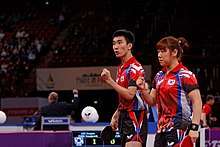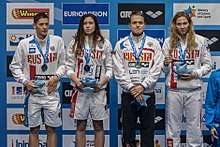Mixed-sex sports

.jpg)
Mixed-sex sports, also known as mixed-gender or coed sports, are sports where the participants are not of a single sex. This can take the form of individual or team sports involving people of different sexes. In organised sports settings, rules usually dictate the number of people required of each sex in a team (for example teams of one man and one woman). Such rules account for the sex differences in human physiology, with males being larger and stronger than females on average. In informal settings, mixed-sex sports typically involves groups of friends and/or family engaging in sport without regard to the sex of the participants.
Sports which are mixed-sex as standard are typically ones where the differences between the sexes do not greatly affect the ability of the competitor, for example equestrian sports. There are also disciplines where there has always been a tradition of multi sex participation like pairs in dancesport. There are also mainly single-sex sports with a variant sub-competition between mixed-sex teams, for example mixed doubles tennis.
Mixed-sex sports have been encouraged as a way of boosting female sports participation and improving social harmony between the sexes.[1] Mixed-sex play and sports is common among young children, among whom differences are less pronounced.
Direct competition
It is uncommon in most organised sports to find individuals of different genders competing head-to-head at elite level, principally due to the differences between the sexes. In sports where these differences are less linked to performance, it is standard practice for men and women to compete in mixed-sex fields. These open-class sports prove accommodating to intersex athletes, who challenge the sex-defined rules of both single-sex sport and mixed-sex sports with defined male and female roles.
In equestrian sports, male and female riders compete against each other in eventing, dressage and show jumping disciplines. Female jockeys compete alongside male ones in horse racing, though the former constitute a minority of jockeys overall. Beyond the athletes, the horses used for racing are a mixed of male and female, with a roughly 60/40 split at the top level between colts and fillies.[2]
During an Ultimate game, teams of 7 players (4 men and 3 women, or 4 women and 3 men) play in direct competition with each other, and while most often people of the same gender mark each other, it is not uncommon to see match ups between people of different gender.
Mixed doubles or pairs

A common form of mixed-sex sports involves pairs with one male and one female team member.
Sports based on dancing often have male/female pairings, such as pair figure skating, ice dancing, ballroom dancing and synchronised swimming duets. In these sports the male and female participants physically work together to produce an artistic and athletic performance.
Mixed doubles involves two mixed-sex pairs competing against each other with all four competitors in open play. This is particularly prominent in racket sports, including tennis, table tennis, badminton, squash and racquetball.
Mixed pairs and mixed teams events are occasionally organised in contract bridge.
Pairs may also compete in turn-based games, where men and women take turns alternately. This is found in more strategy-based sports, including mixed curling, mixed golf, mixed bowling and mixed team darts.[3] Separate male and female performances may also be combined to produce mixed team results in such sports as diving. Synchronised diving is also found in mixed-sex format. Mixed tag team matches are also found in professional wrestling, where wrestlers are not explicitly competing in a turn-based manner, but are usually obliged to only face their opponent of the same sex.[4][5]
Mixed relay

In non-vehicular racing sports the physiological differences between the sexes often preclude head-to-head competition between people of different sexes at the elite level. As a result, mixed-sex events are most often held with a relay race format.
In running, a 4 × 400 metres mixed relay race was introduced at the 2017 IAAF World Relays, and will be added to the 2019 World Championships in Athletics and 2020 Summer Olympics.
In cross-country running, a 4 × 2 km mixed relay race was added at the 2017 IAAF World Cross Country Championships.
In swimming, mixed relay races were introduced at the 2014 FINA World Swimming Championships (25 m) (4 × 50 m freestyle and medley) and the 2015 World Aquatics Championships (4 × 100 m freestyle and medley). The event will debut at the 2020 Summer Olympics (4 × 100 m medley).
In triathlon, the ITU Triathlon Mixed Relay World Championships mixed relay race has been held since 2009. Also, the triathlon at the Youth Olympic Games has a mixed relay race since 2010. As in standard triathlons, each triathlon competitor must do a segment of swimming, cycling and running.
In biathlon, a mixed relay race was first held at the Biathlon World Championships 2005 in Khanty-Mansiysk (4 × 6 km), and it was added to the 2014 Winter Olympics (4 × 6 km / 7.5 km).
Ultimate
The mixed division is a staple of Ultimate, and it is the only division that was showcased at both the 2013 World Games and the 2017 World Games.
Mixed team ball sports
Mixed-sex forms of ball sports involve set numbers of each sex per team, and sometimes pre-defined roles in the team which people of that gender can play. Examples include korfball, coed softball, and wheelchair rugby.
Olympics
Mixed-sex sport has a long history at the Olympic Games, dating back to the 1900 Summer Olympics, which was the first in which women participated. Two women competed against men in the equestrian ,[6] the croquet competition was mixed-sex,[7] while Hélène de Pourtalès was the sole female sailor and first mixed-sex team champion, being part of a gold medal-winning Swiss team.[8] The sole time Olympic motorboating was held in 1908, Sophia Gorham took part in a mixed British team.[9]
Mixed doubles tennis was first contested in 1900 but fell off the programme after 1924 before being reintroduced in 2012.[10] Mixed doubles badminton was introduced in 1996.[11]
Pair figure skating was present at the summer games in 1908 and 1920 before continuing as a founding event at the first Winter Olympic Games.[12] Ice dancing expanded the mixed figure skating programme in 1976.[13]
Sailing at the Summer Olympics was mostly mixed-sex up to 1988 but grew increasingly divided, with no mixed sailing events being held in 2012.[14] Similarly, shooting at the Summer Olympics continued on a mixed basis in several events from 1968 to 1992, before competitors were restricted by sex.[15]
There was an increased focus on mixed-sex competition at the start of the 21st century, with new introductions including mixed biathlon relay, team figure skating, and luge mixed team relay in 2014, then mixed curling and mixed team alpine skiing in 2018. Mixed team shooting events and table tennis mixed doubles are set for inauguration at the 2020 Summer Olympics.[16][17] Mixed-sex relay events are also slated for the 2020 athletics and swimming programmes. These changes were as a result of an initiative by the International Olympic Committee to increase the level of female participation towards parity with men, with the recasting of men's events as mixed-sex ones being part of that change.[18]
References
- ↑ Playing Together—Values and Arrangements of Coed Sports. T&F Online. Retrieved 2018-05-19.
- ↑ MacKenzie, Sheen (2013-06-28). Racing's battle of the sexes -- on four legs. CCN. Retrieved 2018-05-19.
- ↑ Storm Open Festival of Bowling featuring the National Mixed Tournament. National Mixed. Retrieved 2018-05-19.
- ↑ Schwartz, Nick (2017-12-13). WWE is launching a mixed tag team tournament that will air on Facebook. USA Today'. Retrieved 2018-05-19.
- ↑ 7 Times WWE Had Mixed Gender Tag Matches at WrestleMania. What Culture. Retrieved 2018-05-19.
- ↑ Equestrianism at the 1900 Paris Summer Games: Mixed Hacks And Hunter Combined. Sports Reference. Retrieved 2018-05-19.
- ↑ Croquet at the 1900 Paris Summer Games. Sports Reference Retrieved 2018-05-19.
- ↑ Hélène de Pourtalès. Sports Reference. Retrieved 2018-05-19.
- ↑ Sophia Gorham. Sports Reference. Retrieved 2018-05-19.
- ↑ Tennis Mixed Doubles Medalists. Sports Reference. Retrieved 2018-05-19.
- ↑ Mixed Doubles Badminton. Sports Reference. Retrieved 2018-05-19.
- ↑ Figure Skating Mixed Pairs Medalists. Sports Reference. Retrieved 2018-05-19.
- ↑ Figure Skating at the Olympics. Sports Reference. Retrieved 2018-05-19.
- ↑ Sailing. Sports Reference. Retrieved 2018-05-19.
- ↑ Shooting. Sports Reference. Retrieved 2018-05-19.
- ↑ Table Tennis Mixed Doubles Added to Tokyo 2020. ITTF (2017-06-09). Retrieved 2018-05-19.
- ↑ ISSF approves mixed gender shooting events for 2020 Tokyo Olympics First Post (2017-02-24). Retrieved 2018-05-19.
- ↑ Olympics Shift: IOC Doubles Number Of Mixed-Gender Events, Adds 5 Sports. NPR (2017-06-09). Retrieved 2018-05-19.